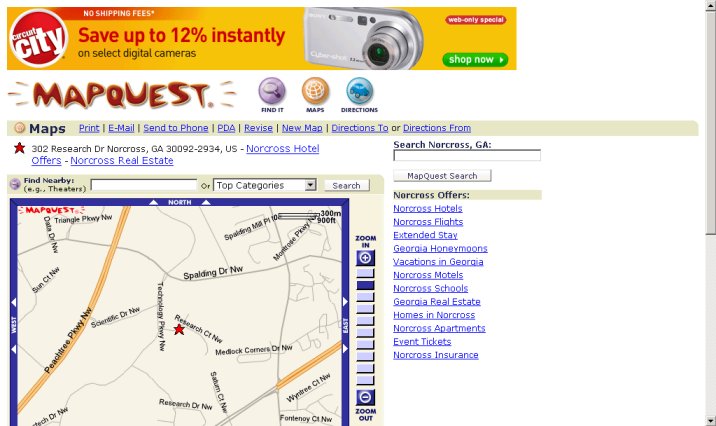20 June 2005
Immersion
Drinking with someone the other night, we got into an argument about the relevancy of the new directions that search engines are taking. Amazon's A9 displays storefronts [SearchEngineWatch] as photographed from a fleet of vans. Google's map displays satellite images [SearchEngineWatch] of the area that you're viewing, and they are planning 3D enhancements [SearchEngineWatch] as reported in eWeek. MSN is developing a Virtual Earth [SearchEngineWatch] using a fleet of low-flying planes. On top of that, Google has just added the world [via /.]. Most places are lo-res satellite or country placeholders, yet their future intentions are clear.
Are these features just "cool," or do they add enough value to be around for a while?
My defense centers around the fact that, basically, pictures add value: you could find destinations by navigating purely textual directions (go left at the stop light, etc.), and yet no one would argue that the visual information within maps are merely cool. Some points:
- Storefronts can help you familiarize yourself with a neighborhood. We could have used it in NYC for all the new places we went to (and got lost).
- Satellite imagery can provide details that lines on a map do not. Visitors at work are always entering the wrong door and wandering around the building. From the satellite view, they could see where the "south side of the building" is in relation to the main road.
- Satellite imagery provides route details such as congested 2-lane v. free-flowing 6-lane highways, or whether an intersection is unpopulated or commercialy dense and likely to be highly trafficked.
Are any of these "killer" features? No, but they don't need to be. With such rich search engine competition, each is improved so that even if only 20% of users find a new feature useful, it will get added (20% was someone's threshold of uselessness). If users switch at that threshold, an engine with 30% market share could increase that market share by 50% (20% of 70% is 14%). Add to that any number of other, seemingly minor features and the small differences become significant. For me, Google map's combination of drag navigation (simply dragging with the mouse repositions the map), no ads, and an alway-in-view display (the map view resizes to fit the size of your browser) trump major features from other engines' sites. Taken together, those three features eliminate the tedious process of first clicking to navigate, waiting for the refresh, scrolling down past the ads, and then repeating two or three times in order to view a map that's on 1/4-1/3 the viewing space of my browser's window.
A comparison (because, as someone once said, pictures add value):



- AI and tomorrow posted by sstrader on 31 March 2016 at 11:29:29 PM
- The city posted by sstrader on 6 March 2016 at 9:43:27 PM
- Race, actors, representation posted by sstrader on 22 January 2016 at 5:29:53 PM
- When should you not report a name? posted by sstrader on 4 October 2015 at 11:11:36 AM
- Health cost posted by sstrader on 18 September 2015 at 10:39:05 AM